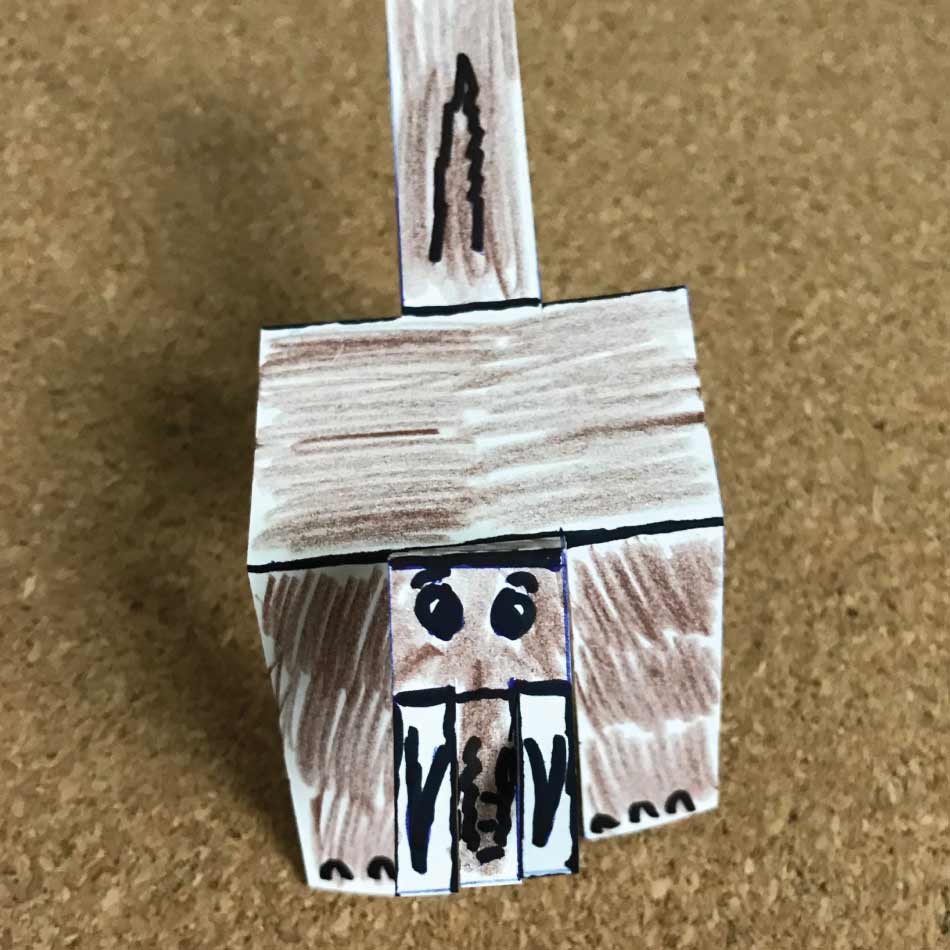Build a Mammoth Ramp Walker
Use the fundamentals of physics to create a “walking” mammoth
- All
- Things to Make
- Experiments

What you’ll need:
- Mammoth ramp walker template
- Printer
- Card stock or recycled cardboard
- Scissors
- Markers, pencil crayons or other materials for decorating your mammoth
- A rough, textured surface, like corkboard or a plank of wood
- Something sturdy to prop up the planks, like books
No printer? No problem! Grab a pencil and ruler to draw your own template using the measurements provided.


Activity setup:
- Print the template on card stock. Drawing your own? Feel free to use card stock or thin recycled cardboard, like a cereal box.
- Follow the template to cut the outline as needed with your scissors. Be sure to cut small curves on the bottom of the mammoth's legs, as indicated on the template.
- Colour and decorate your mammoth’s head, body, legs and tail.
- Once your mammoth is decorated, use the template as a guide to fold its legs downward. Be sure to create a firm crease.
- Follow the dotted lines on the template to fold the mammoth's neck and tail in the opposite direction of its legs. To give your mammoth a head, fold the last dotted line at the top of its neck.
- Set up a pile of books on top of a flat surface. Rest one end of your corkboard or plank of wood on the books and place the other end on your surface to create a ramp.
- Place your mammoth at the top of your ramp. Lean the mammoth slightly to the left or right side to help it get started.
- Release the mammoth and watch it walk down the ramp!

Experiment:
There are many ways to experiment with your mammoth ramp walker! Here are a few things to try:
- Use different materials for your ramp. What happens when you use a thicker material, like wood, compared to a thinner material, like stock paper?
- Play around with different ramp surfaces. Try adding materials like plastic wrap or rubber placemats to your ramp. You can also try making your cardboard or wood more rough using sandpaper.
- Change the curvature of your mammoth’s feet. Does your mammoth move better when its feet are flatter or more curved?
- Try adding weight to the front or back of your mammoth using paperclips or extra cardboard. How does this affect its walking?
- Make multiple mammoths with different dimensions and race them. Will a mammoth with longer legs move faster? What about a bigger body?

How does it work?
There are two simple machines causing the life-like walking movements of your mammoth ramp walker: levers (the mammoth’s legs and feet) and an incline plane (the ramp).
The curvature of the mammoth’s feet is key to its movement. The small curves added to the feet cause the mammoth to rock back and forth from one leg to another. One front leg makes contact with the surface of the ramp while the other leg lifts up, causing the mammoth to “walk.” A transfer of energy also takes place: The potential energy from the leg touching the surface is transferred to kinetic energy when the leg lifts up and springs forward.
For the ramp to work, it needs to have a certain level of friction and the proper angle. If the ramp’s surface is too smooth, the mammoth will slide down; if it’s too rough, the mammoth will not move at all. If the ramp is too steep, the mammoth will tumble down; if it’s too flat, the mammoth will stand still.
Cool fact:
Mammoths stood and walked on their toes! A large pad between the mammoth’s toes added support to their feet, allowing them to stand on their toes. The soles of their feet had many cracks, which allowed them to grip surfaces while they walked. Cats, dogs and other mammals also walk like this.